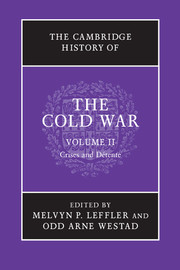Book contents
- Frontmatter
- 1 Grand strategies in the Cold War
- 2 Identity and the Cold War
- 3 Economic aspects of the Cold War, 1962–1975
- 4 The Cuban missile crisis
- 5 Nuclear competition in an era of stalemate, 1963–1975
- 6 US foreign policy from Kennedy to Johnson
- 7 Soviet foreign policy, 1962–1975
- 8 France, “Gaullism,” and the Cold War
- 9 European integration and the Cold War
- 10 Détente in Europe, 1962–1975
- 11 Eastern Europe: Stalinism to Solidarity
- 12 The Cold War and the transformation of the Mediterranean, 1960–1975
- 13 The Cold War in the Third World, 1963–1975
- 14 The Indochina wars and the Cold War, 1945–1975
- 15 The Cold War in the Middle East: Suez crisis to Camp David Accords
- 16 Cuba and the Cold War, 1959–1980
- 17 The Sino-Soviet split
- 18 Détente in the Nixon–Ford years, 1969–1976
- 19 Nuclear proliferation and non-proliferation during the Cold War
- 20 Intelligence in the Cold War
- 21 Reading, viewing, and tuning in to the Cold War
- 22 Counter-cultures: the rebellions against the Cold War order, 1965–1975
- 23 The structure of great power politics, 1963–1975
- 24 The Cold War and the social and economic history of the twentieth century
- Bibliographical essay
- Index
- References
9 - European integration and the Cold War
Published online by Cambridge University Press: 28 September 2010
- Frontmatter
- 1 Grand strategies in the Cold War
- 2 Identity and the Cold War
- 3 Economic aspects of the Cold War, 1962–1975
- 4 The Cuban missile crisis
- 5 Nuclear competition in an era of stalemate, 1963–1975
- 6 US foreign policy from Kennedy to Johnson
- 7 Soviet foreign policy, 1962–1975
- 8 France, “Gaullism,” and the Cold War
- 9 European integration and the Cold War
- 10 Détente in Europe, 1962–1975
- 11 Eastern Europe: Stalinism to Solidarity
- 12 The Cold War and the transformation of the Mediterranean, 1960–1975
- 13 The Cold War in the Third World, 1963–1975
- 14 The Indochina wars and the Cold War, 1945–1975
- 15 The Cold War in the Middle East: Suez crisis to Camp David Accords
- 16 Cuba and the Cold War, 1959–1980
- 17 The Sino-Soviet split
- 18 Détente in the Nixon–Ford years, 1969–1976
- 19 Nuclear proliferation and non-proliferation during the Cold War
- 20 Intelligence in the Cold War
- 21 Reading, viewing, and tuning in to the Cold War
- 22 Counter-cultures: the rebellions against the Cold War order, 1965–1975
- 23 The structure of great power politics, 1963–1975
- 24 The Cold War and the social and economic history of the twentieth century
- Bibliographical essay
- Index
- References
Summary
European integration and the Cold War were separate but intertwined. Chronologically, the two share the same formative decades – although the basic idea of uniting the separate states of Europe into a single political and economic entity long predates the East–West conflict. Both European unity and the course of the Cold War became, moreover, central preoccupations of Western leaders on both sides of the Atlantic throughout the 1947–89 period. Yet more often than not, European integration and the Cold War have been studied in near total isolation from one another, the subject of separate journals, academic conferences and books, and the primary interest of two distinct groups of specialist scholars who have rarely exchanged ideas. This chapter will hence begin with a brief explanation of why this separation has occurred, before going on to argue that the interaction between the evolution of the Cold War and the gradual development of today’s European Union (EU) was so intimate as to make it vital for historians to break down the barriers between the two fields.
One of the reasons why the two historiographies have diverged is that the most consistently successful forms of European integration have been primarily concerned with economic matters rather than military or political cooperation. Of the two economic and military plans launched within months of each other in 1950, the Schuman Plan – intended to pool the coal and steel industries of France, Germany, Italy, and the Benelux countries – succeeded in bringing the European Coal and Steel Community (ECSC) into being in 1952.
- Type
- Chapter
- Information
- The Cambridge History of the Cold War , pp. 179 - 197Publisher: Cambridge University PressPrint publication year: 2010
References
- 8
- Cited by

